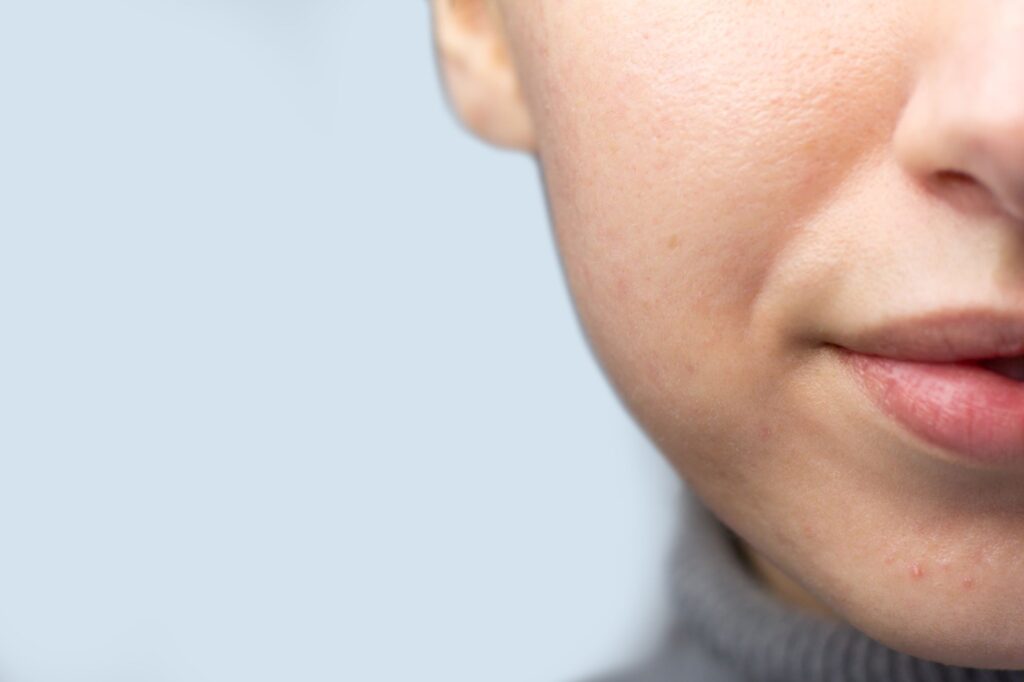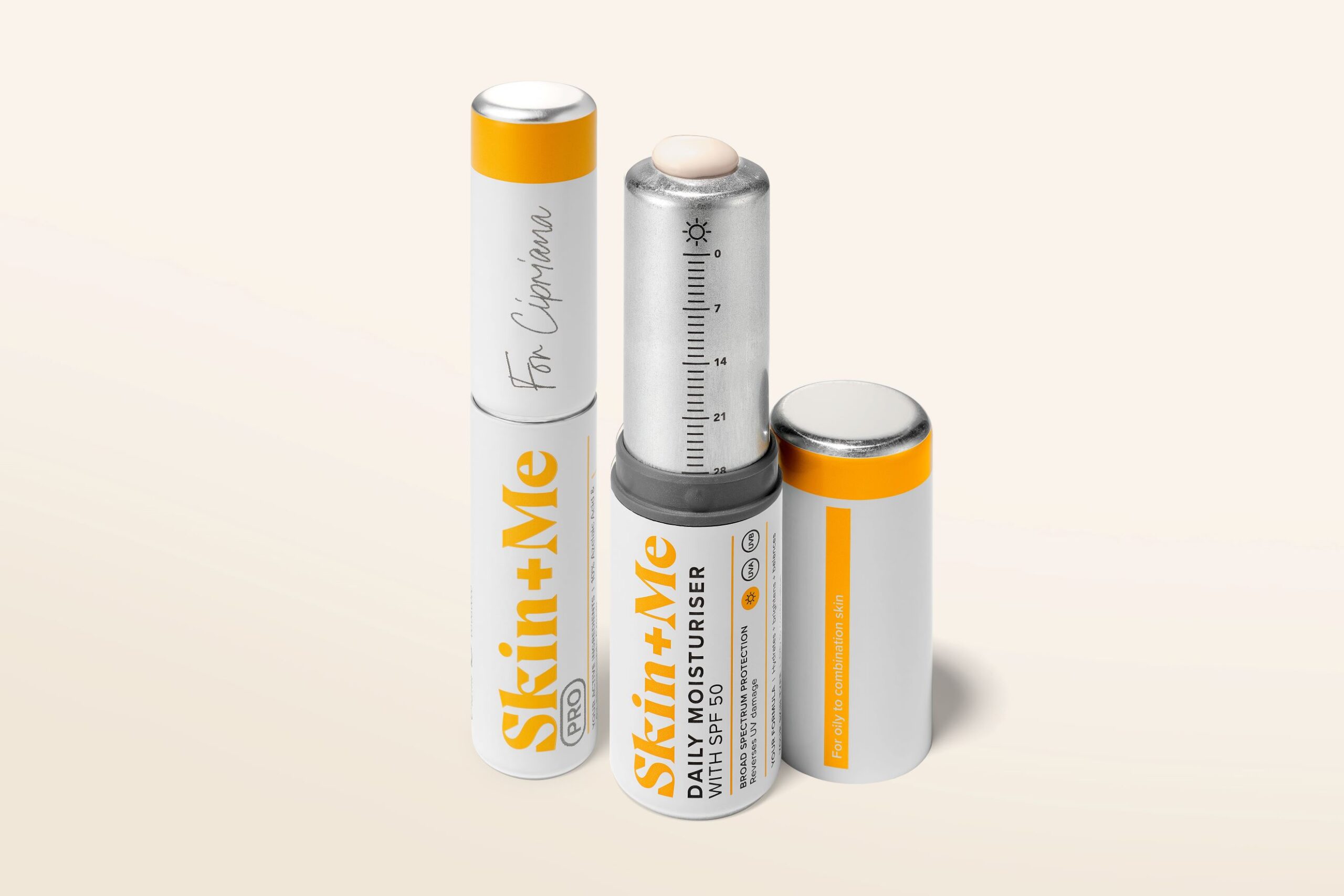Meet the Daily Moisturiser that guarantees SPF 50 – with every click

Link to share article here:
Ask A Dermatologist: What Is Post-Inflammatory Erythema?
As if waiting for spots to heal isn’t bad enough, sometimes you’re left with marks long after the pimples have left the building.
But did you know that there’s actually a medical term for the irritated (and irritating) patches that linger in the aftermath of acne? It’s known in dermatology circles as post-inflammatory erythema – or PIE for short.
Despite its sweet name, this frustrating condition can be stubborn – but luckily there are several treatment options out there. Depending on the severity of your PIE, you can either choose to tackle it at home, using a dermatologist-approved skincare routine, or visit a clinic for a cosmetic treatment. Read on for our deep dive into all things PIE.
What Is Post-Inflammatory Erythema?
Post-inflammatory erythema (PIE) is the name for the pink or red marks left on the skin by acne. PIE is not a type of scarring or hyperpigmentation – rather, it is left over by the irritation in a particular area of unhappy skin.
PIE is more common in people with fairer skin types, while darker skin is more likely to experience post-inflammatory hyperpigmentation. This is when dark brown or grey spots occur due to an increase in melanin production.
What Causes Post-Inflammatory Erythema?
Post-inflammatory erythema is brought on by the swelling and trauma to the skin caused by spots. It usually occurs after a bout of moderate or severe acne. If your skin is on the oilier side, you’re more likely to experience PIE.
Blackheads and whiteheads, also known as comedonal acne, are less likely to cause PIE than papules and pustules, which are small red bumps that can feel tender. It can also be triggered by an excess of dead skin cells which linger in the skin follicles and cause irritation.
How Can You Avoid Post-Inflammatory Erythema?
Targeting the root cause of PIE should be your first port of call – this means treating your acne and getting it under control. Your GP or dermatology clinician should be able to advise the best course of action to treat spots.
It’s important that you avoid picking or squeezing your spots. As tempting as it can be, this can make PIE worse and prolong the healing process. Instead, take a deep breath and find something to distract you – we promise the damage is not worth the momentary feeling of satisfaction. Or, try using a spot patch to provide a physical barrier.
Sunscreen is also non-negotiable. A high SPF like Skin + Me Daily Defence Oil Free Sunscreen SPF50 will protect your skin from sun damage, which can make any marks on your face appear more pronounced. It’s also really important to use sunscreen if you’re using powerful active ingredients, as they can make your skin more photosensitive, meaning it is sensitive to sunlight.
And, make sure you’re gentle with your skin. PIE is a sign that it has been irritated, so the last thing it needs is more stress. Stay away from harsh cleansers, exfoliants or scrubs, pat your face dry with a soft towel rather than rubbing and don’t overload it with products.
How Can You Treat Post-Inflammatory Erythema?
There are several ways to treat post-inflammatory erythema, ranging from affordable at-home options to more expensive clinic treatments. How successful your treatment is will depend on the severity of your PIE and your skin type.
When it comes to using active skincare ingredients, it’s important to remember that they will take time to work. At Skin + Me, we tell members that they can expect to see some visible results after 90 days of using their personalised Daily Doser treatment. It’s an ongoing process – the number one thing you can do is keep your routine consistent.
And, when it comes to aesthetic treatments in the salon, you will likely need multiple sessions and results can vary. Your cosmetic practitioner will advise you on the best plan for your skin’s needs.
Tretinoin
Tretinoin is a prescription-only ingredient that can tackle a range of skin concerns, including PIE. “Tretinoin belongs to a family of synthetic and naturally occurring compounds called retinoids that are all derived from Vitamin A,” explains Dr Ben Esdaile, Consultant Dermatologist at Skin + Me.
“Tretinoin works directly on the retinoic acid receptors found on your skin cells, making it the most powerful retinoid available. Tretinoin was first used in 1962 and has over 50 years of scientific evidence resulting from clinical use to support its efficacy.” Just remember that retinoids are not safe to use during pregnancy.
Niacinamide
Niacinamide is another all-round hero ingredient that can be helpful if you’re dealing with PIE. It’s a form of Vitamin B3 that reduces skin discolouration and regulates oil production. Available on the high street, it’s gentler than retinoids, so it’s a good pick for sensitive skin, or if you’re pregnant.
“Niacinamide is great at calming the skin and inflammation and I like using it in combination with the other products,” says Dr Ben. “When you start over the counter products make sure you are using them regularly and using them for at least a six to eight week period to establish if they make a difference.”
“The problem I often see is that people change their products too often and too quickly, but skin takes time to improve and you won’t know if something is beneficial after only a few weeks.”
Clindamycin
Your dermatologist might prescribe clindamycin if you’re struggling with acne. This antibiotic stops the growth of acne-causing bacteria and promotes skin recovery, reducing the likelihood of PIE.
“Topical antibiotics such as clindamycin and erythromycin can be very useful for the treatment of the inflammatory component of your acne – this is the redness and the red spots that you are getting,” says Dr Ben.
Clindamycin should only be used under a doctor’s supervision and for a limited period of time, to prevent antibiotic resistance. It is not recommended that you use clindamycin if you’re pregnant or breastfeeding.
Metronizadole
Metronizadole is another antibiotic that targets the bacteria that cause acne. It can help to clear up your skin and reduce the likelihood of scarring. Metronidazole is only available on prescription, and as with clindamycin it shouldn’t be used when pregnant or breastfeeding, or for a prolonged period.
Azelaic Acid
Azelaic acid is an antioxidant with anti-inflammatory and anti-bacterial properties. “It is a naturally occurring substance produced by yeast with a long list of benefits to the skin,” says Dr Ben.
“It is useful for acne-prone skin particularly those with sensitive skin who may struggle to tolerate retinoids. Azelaic acid acts as a chemical exfoliator by unblocking the pores that have become blocked in acne.”
“It penetrates down the blocked pore and helps break up the blockage as well as killing the bacteria that drives acne. Its anti-inflammatory properties make it extremely useful in helping reduce swelling and redness”.
Laser treatment
It’s an expensive option, but lasers can be effective when topical treatments aren’t enough. Your cosmetologist will use light therapy to target and remove the blood vessels which cause redness, essentially speeding up the healing process. Results from laser can vary, and you might need several sessions before you see an improvement in your PIE.
Microdermabrasion
Again, microdermabrasion is one of the pricier options for treating PIE. This cosmetic procedure is carried out in-salon, and uses fine crystals and a vacuum to remove dead skin cells. Again, you might need to go back for more than one session for the best results – speak to your cosmetic specialist for all the information you need.
New to Skin + Me? Get your first month of personalised skincare for £4.99 with promo code DOSE – complete our quick consultation here.
Looking for a routine refresh? Add the Dream Routine to your Skin + Me subscription.
In need of a restock? Head to The Skincare Shop for one-off purchases of your Routine Essentials.



